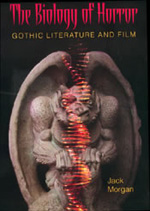Biology of horror is subject of new book by UMR’s Jack Morgan
Posted by news
ROLLA, Mo. – There is more to the element of horror in books and film than the gross-out, in-your-face horror of films like Friday the 13th or Nightmare on Elm Street, says Jack Morgan, an instructor in the English department at the University of Missouri-Rolla.
 |
Morgan has written a book on the subject, "The Biology of Horror: Gothic Literature and Film," which will be published this month by Southern Illinois University Press.
More important than the gross-out factor, Morgan says, are the deeper, underlying rhythms of dread and anxiety found in Gothic literature and film. And while fear is a common element in horror stories, some are based entirely on those ongoing elements with no terror-filled climax.
"A good example of that is the original 1956 version of Invasion of the Body Snatchers," Morgan says. "There is no blood or guts, just people being slowly taken over. It’s the sense of disestablishment of order that gets to you."
What constitutes Gothic is open to question, Morgan says. "The term may be used in a limited sense — the ‘high’ Gothic novels of the late 18th through the 19th century," he says. "But Gothic has come to be used more generically to refer to macabre, weird literary material in general — horror." In his book, Morgan uses the second, more generic definition.
"We are experiencing a renaissance of Gothic literature today," says Morgan. "There are a tremendous number of people writing Gothic fiction today." Authors like Stephen King, Clive Barker, Katkin Kiernan and Peter Straub are just a few who are experiencing popular success. "These writers grew up on the Gothic horror films of the 1930s, 40s and 50s."
Morgan’s book, for one thing, examines the point where Gothic film and literature intersect. Historically film has been the most powerful Gothic medium to appear since the ‘high-Gothic’ novel, Morgan says.
He uses Frankenstein to illustrate his point. When most people think of Frankenstein, the image they picture is that of the monster Boris Karloff portrayed in the 1931 film version. But Karloff’s version differs significantly from the novel it was based on, Mary Shelley’s "Frankenstein: or, The Modern Prometheus," originally published in 1818.
Morgan was inspired to start work on the book after teaching Herman Melville’s story, "Benito Cereno," a common feature in American Literature survey courses. "It’s such a problematical story," he says. "It raised questions in my mind about the nature of dark, Gothic literature and how it works."
"Benito Cereno" tells the story of African slaves revolting and taking over the Spanish ship on which they were imprisoned. "The story is politically and morally problematic because the situation of slavery is not dealt with as sympathetically as you would think," Morgan says. "Today, slavery is a horrifying topic, but in the Melville story, the slave takeover of the ship seems to be the horrifying element."
Morgan is currently working on a second book on horror, tentatively titled "Games in the Ghastly Mansion: Play and the Poetics of Gothic." The title refers to the scene in Charles Dickens’ novel "Great Expectations" where Miss Havisham requires Pip to play. This time Morgan focuses on the connection between play and horror. "A common theme in horror films and literature is the abduction or murder of a child while playing — the monster lurking in the shadows, watching the children play," Morgan says. "That juxtaposition of play and horror is the central theme. At the moment, for instance, it is implicit in the image of a sniper drawing a bead on a playing child in a schoolyard — the terrible incongruity of that."